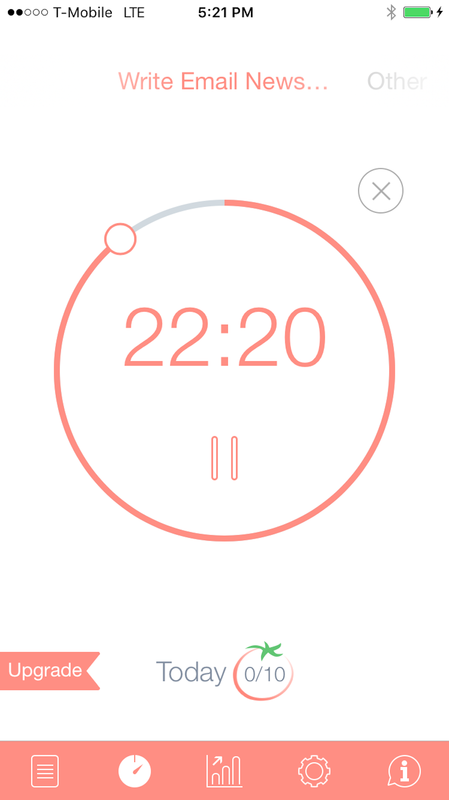Running your own business means constant distraction. A one hour task can balloon into a three hour job as you're pulled away by minor interruptions from Facebook, email, TV, family, friends, pets, birds chirping outside, an ant slowly crossing your desk. These distractions don't make you feel like you've done an hour of work while taking fun breaks every few minutes, they make it feel like you've been working hard for three hours.
Time management sounds difficult, but it frees you from tedium so you can accomplish more while gaining extra time for yourself. There are as many time management techniques as there are distractions to keep you from making the most of your time, but these are among the most useful I've seen.
The Pomodoro Technique
This time management technique, surprisingly, has very little to do with delicious pasta sauces (pomodoro being the Italian word for tomato). It's instead a system developed by Francesco Cirillo in which you set a certain amount of time to focus on the task at hand — usually around 25 minutes, though there's no need to hold yourself to that exact number — followed by a 5 to 15 minute break to do whatever you like. Two hours of work using the Pomodoro Technique might look like this:
Knowing there's a break coming up soon can make it much easier to focus. You might even get things rolling so that you keep working right past the buzz of the timer, pushing your break to when you feel like you need it.
There are a number of time management apps to get you started with the Pomodoro Technique, like Pomodoro Time (iOS), Timesheet (Android) and Pomodoro.cc (Web). Of course, you may find it just as easy to manually set a timer and manage the Pomodoro Technique yourself.
The Pomodoro Technique
This time management technique, surprisingly, has very little to do with delicious pasta sauces (pomodoro being the Italian word for tomato). It's instead a system developed by Francesco Cirillo in which you set a certain amount of time to focus on the task at hand — usually around 25 minutes, though there's no need to hold yourself to that exact number — followed by a 5 to 15 minute break to do whatever you like. Two hours of work using the Pomodoro Technique might look like this:
- Set timer for 25 minutes.
- 10 minute break.
- Set timer for 45 minutes.
- 15 minute break.
- Set timer for 25 minutes.
- All done!
Knowing there's a break coming up soon can make it much easier to focus. You might even get things rolling so that you keep working right past the buzz of the timer, pushing your break to when you feel like you need it.
There are a number of time management apps to get you started with the Pomodoro Technique, like Pomodoro Time (iOS), Timesheet (Android) and Pomodoro.cc (Web). Of course, you may find it just as easy to manually set a timer and manage the Pomodoro Technique yourself.
What if you don't have several hours every day to fiddle around with on and off time? Consider planning one of these:
The Power Hour
Schedule an hour every day to do nothing but work on one task, like writing a blog post or creating emails for your growing mailing list. To help stay on task, plan to reward yourself when the Power Hour is up, maybe with a cup of tea or an episode of a favorite TV show.
If you find Power Hours effective as a time management technique, you could even set your entire work day around them. Get up, work from 8am to 9am, do something else until 10:30, work from 10:30 to 11:30, take a 30 minute break, and on from there. This essentially would become your own variation on the Pomodoro Technique.
Eat the Frog
"Eat a live frog first thing in the morning and nothing worse will happen to you the rest of the day." - Mark Twain
The Power Hour
Schedule an hour every day to do nothing but work on one task, like writing a blog post or creating emails for your growing mailing list. To help stay on task, plan to reward yourself when the Power Hour is up, maybe with a cup of tea or an episode of a favorite TV show.
If you find Power Hours effective as a time management technique, you could even set your entire work day around them. Get up, work from 8am to 9am, do something else until 10:30, work from 10:30 to 11:30, take a 30 minute break, and on from there. This essentially would become your own variation on the Pomodoro Technique.
Eat the Frog
"Eat a live frog first thing in the morning and nothing worse will happen to you the rest of the day." - Mark Twain
This is not only true of eating frogs (which we don't usually recommend), it's also true of your most unenjoyable tasks. Make the first thing you accomplish every day the thing you least want to tackle and the rest of the day will seem incredibly easy by comparison. Twain wrote 28 books and countless short stories and articles, so he clearly knew a thing or two about time management techniques.
If you need motivation to manage your time, consider Parkinson's Law and Horstman's Corollary. The first says "work expands to fill the time we give it." But the second adds to this by stating that "work contracts to fit the time we give it."
If you give yourself a few very focused hours (or even one such hour) every day, you may find your own work contracting and that you're getting more done in half the time. That makes it certainly worth exploring some time management techniques for yourself.
Ready to give your idea a website? Get started for free!
If you need motivation to manage your time, consider Parkinson's Law and Horstman's Corollary. The first says "work expands to fill the time we give it." But the second adds to this by stating that "work contracts to fit the time we give it."
If you give yourself a few very focused hours (or even one such hour) every day, you may find your own work contracting and that you're getting more done in half the time. That makes it certainly worth exploring some time management techniques for yourself.
Ready to give your idea a website? Get started for free!
 Ezra Meyers Ezra is a freelance writer focused on web development, email marketing and baseball. He lives in Los Angeles, but wishes he lived in Tokyo.
Ezra Meyers Ezra is a freelance writer focused on web development, email marketing and baseball. He lives in Los Angeles, but wishes he lived in Tokyo.







